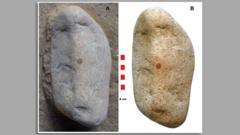Recent research reveals the oldest human fingerprint on a pebble believed to have been intentionally painted by a Neanderthal in Spain, hinting at their potential for abstract thinking and artistic expression.
Discovery of Ancient Neanderthal Fingerprint Suggests Artistic Expressions

Discovery of Ancient Neanderthal Fingerprint Suggests Artistic Expressions
A remarkable find in Spain indicates that Neanderthals may have created art, challenging long-held perceptions of their cognitive capabilities.
Scientists in Spain have made an astonishing discovery that could reshape our understanding of Neanderthals and their cognitive abilities. Researchers unearthed what is believed to be the oldest full human fingerprint on a pebble that appears to have been painted with red pigment, resembling a human face. This remarkable find, dating back approximately 43,000 years, was located at the San Lázaro rock shelter in Segovia.
According to study co-author María de Andrés-Herrero from the University of Complutense in Madrid, the positioning of the red dot on the pebble suggests that Neanderthals were capable of symbolic behavior and abstract thought. During an interview with BBC's Newsday, Prof de Andrés-Herrero explained that excavation efforts at the site began five years prior, and significant progress was made in 2022 when they discovered the stone buried beneath 1.5 meters of sediment from Neanderthal habitation.
Initially, the research team struggled to comprehend their find, as the painted stone differed significantly in size and appearance from others found at the site. After confirming that the pigment used was indeed a natural clay ochre, they enlisted assistance from Spain's scientific police to conduct further analysis, which ultimately led to the identification of a human fingerprint.
Although the analysis suggested the fingerprint belonged to an adult male, co-author David Álvarez Alonso noted the absence of comparable Neanderthal prints, making definitive identification challenging. During a public news conference, Spanish official Gonzalo Santonja highlighted that this pebble represents the oldest known painted portable object in Europe, and the only instance of portable art attributed to Neanderthals.
Prof de Andrés-Herrero emphasized that this discovery adds significant depth to the discussion surrounding Neanderthals' symbolic capacities, being the first documented example of pigment-marked objects found in an archaeological context. The placement of the fingerprint in a non-utilitarian context indicates the mark could be interpreted as an artistic endeavor.
Furthermore, it is believed that this Neanderthal intentionally chose the pebble due to its unique fissures and marked it with ochre—a pigment that was not naturally present in the rock shelter. The research team stated in their paper published in the journal Archaeological and Anthropological Sciences that the features of the pebble merit consideration as a visual symbol, potentially categorizing it as portable art under certain interpretations.





















